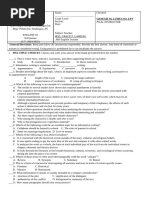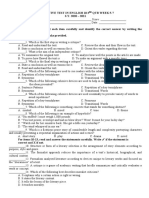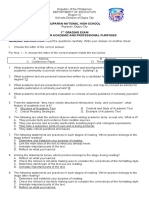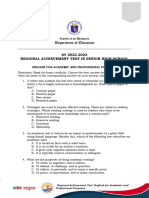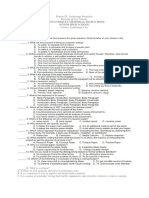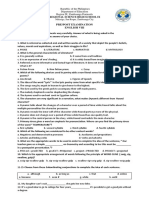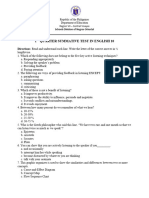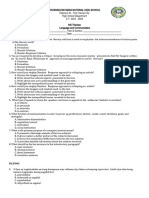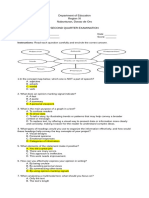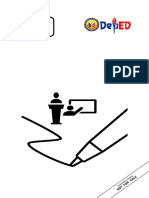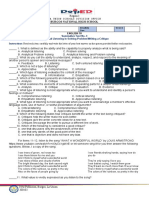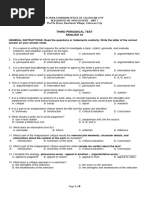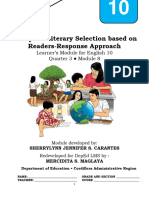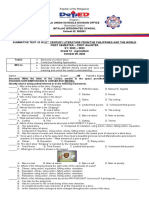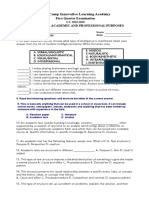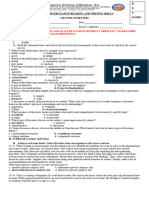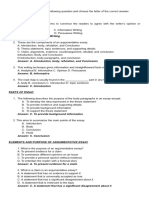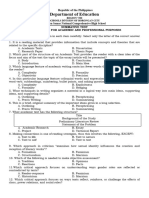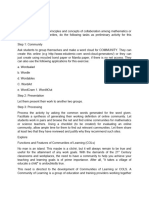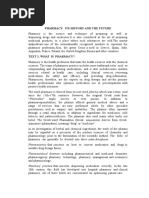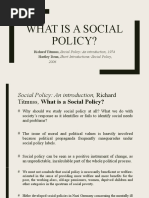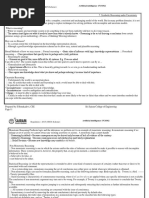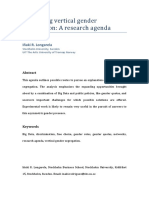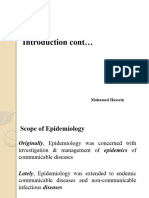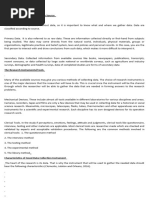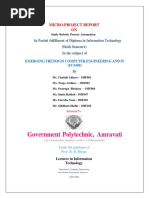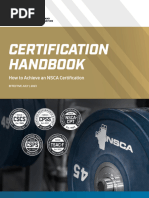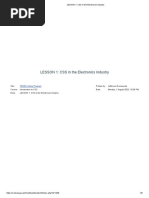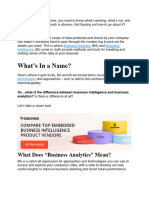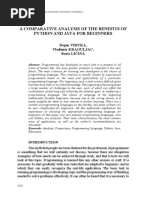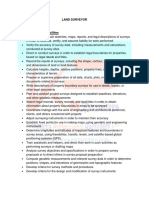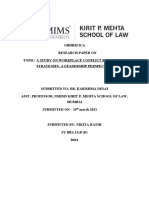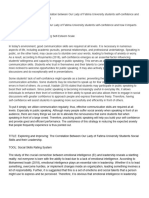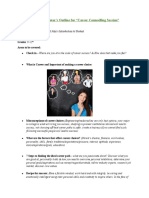Summative Examination Name: - Grade §ion: - Score: - Teacher: - Date
Summative Examination Name: - Grade §ion: - Score: - Teacher: - Date
Uploaded by
Jensine Cabuyao ObodCopyright:
Available Formats
Summative Examination Name: - Grade §ion: - Score: - Teacher: - Date
Summative Examination Name: - Grade §ion: - Score: - Teacher: - Date
Uploaded by
Jensine Cabuyao ObodOriginal Title
Copyright
Available Formats
Share this document
Did you find this document useful?
Is this content inappropriate?
Copyright:
Available Formats
Summative Examination Name: - Grade §ion: - Score: - Teacher: - Date
Summative Examination Name: - Grade §ion: - Score: - Teacher: - Date
Uploaded by
Jensine Cabuyao ObodCopyright:
Available Formats
pRepublic of the Philippines
Department of Education
San Vicente National High School
San Vicente, Jabonga, Agusan del Norte
ENGLISH 10
SUMMATIVE EXAMINATION
Name: ___________________________________Grade &Section:______________Score: _______
Teacher: _________________________________ Date: ___________
Part I. Directions: Read each item carefully. Write the letter that best answers each question on your
answer sheet.
Directions: Read and choose the best answer. Write the letter of your choice on a separate sheet.
1. Which of the following supports the idea of structuralist/formalist?
A. It studies the text, without considering any external influence.
B. It focuses on cultural beliefs, without showcasing the importance of cultural diversity.
C. It serves as reminders, without empathizing with the various challenges in life.
D. It fosters a better relationship, without the real views of people.
2. Which of the following statements is following the moralistic view in critiquing a literary selection?
A. It is anchored on viewing the importance of factual events.
B. It is predetermined based on crafting possible problems to solutions.
C. It is focused on judging the value of literature according to moral lessons or ethical concerns.
D. It is centered on aligning basic literary concepts.
3. All these options support the Marxist’s way of critiquing a literary text, except:
A. It discusses literary factual concerns.
B. It focuses on important practical issues.
C. It views literary works as reflections of the social institutions.
D. It assesses trivial matters.
4. When making a feminist approach in critiquing a literary selection, it is expected to:
A. expose various ways to reinforce or undermine the economic, political, social, psychological subjugation of
women.
B. focus on several ways to emphasize that women are more powerful than men.
C. argue on numerous accounts that women can do better in producing outputs.
D. contend more ideas that women should learn how to control their emotions.
5. Which of the following learning concepts differentiates Historical from the Readerresponse points of view?
A. Historical criticism talks about culture, nevertheless Reader-response seems to
dwell on sharing comments.
B. Historical criticism recounts details, but Reader-response displays various sentiments.
C. Historical criticism involves beyond the literature at the wider historical and cultural events happening during the
text was written, while Reader-response is centered on readers’ reactions to literature.
D. Historical criticism encompasses emotions, whereas Reader-response is focused on possible replies taken from the
reading selection.
6. Which of these terms is often used interchangeably with the word “critique”?
A. Summary B. Synopsis C. Review D. Report
7. Which statement is not true about a critique?
A. It is a purely opinionated piece of writing about a story, novel, film, etc.
B. It is usually done by experts or people with considerable knowledge about the work.
C. It does not place emphasis on giving recommendations to possible readers or viewers.
D. It is an in-depth evaluation or assessment of a piece of work such as a short story or film.
8. Which of these story elements is not tackled in a critique?
A. Characterization B. Conflict C. Plot D. None of the above
9. Which of these is not an appropriate subject for critical analysis?
A. Films B. Novels C. Speeches D. Short Stories
10. Which of these is not an appropriate subject for critical analysis?
A. Films B. Novels C. Speeches D. Short Stories
11. What information or details is usually included in a critique’s introduction?
A. structure of the plot
B. authenticity of the conflict
C. significance of the dialogues
D. background or summary of the text
12. Which of these questions should be asked when analyzing the characters in a narrative?
A. How are the characters developed and what makes them interesting and relatable?
B. Are there equal number of male and female characters?
C. Who among the characters is likeable and who is not?
D. Why is the protagonist not a superhero material?
13. What detail can a critic use best to support his/her evaluation of a story?
A. Opinions of those who read the story
B. Quotes from the story itself
C. Statements of the author
D. Reviews of other critics
14. It scrutinizes both political and social conditions of the literary work.
a. Structuralist b. Moralist c. Marxist d. Feminist
15. It gives more value to study the literary pieces ethical concerns.
a. Feminist b. Structuralist c. Marxist d. Moralist
16. The form of the work is primarily being studied to understand the selection better.
a. Structuralist b. Feminist c. Marxist d. Moralist
For numbers 17-21, Direction: Write TRUE if the statement is correct, and FALSE if not.
________ 17. Critiques may follow different formats but they generally have the same content or foci.
________ 18. A critique is intended primarily to point out the faults or flaws in work.
________ 19. It is alright to not give a summary of the story critiqued because the readers are most likely familiar
with it already.
________ 20. A critic is encouraged to write “I think…” or “In my opinion…” in his/her critical essay.
________ 21. A critique is intended primarily to point out the faults or flaws in work.
For numbers 22-25, Direction: Identify the correct order of these steps in writing a critique by assigning the numbers
1 to 4.
_____ 22. Give recommendations as needed.
_____ 23. Give a short summary of the story.
_____ 24. Give an overall evaluation of the story.
_____ 25. State your analysis of the setting, characterization, plot, et
ENGLISH 10 – QUARTER 3
PERFORMANCE TASK 3 ( Modules 5 and 6)
Directions: Use “Smoking in Public Places should be Banned” Critique as a point of reference to further make a one –
paragraph literary Critique of your own. Use a separate sheet in completing this task. Be guided in the following
marks for assessment:
Content: ------------- 50%
Language Use: ----- 30%
Organization: ------ 20%
100%
You might also like
- (Cambridge Introductions To Philosophy) Kent W. Staley - An Introduction To The Philosophy of Science-Cambridge University Press (2014) PDFDocument212 pages(Cambridge Introductions To Philosophy) Kent W. Staley - An Introduction To The Philosophy of Science-Cambridge University Press (2014) PDFRianda Marta Derici100% (8)
- The Historian and His FactsDocument14 pagesThe Historian and His FactsGeorge AngelesNo ratings yet
- Test Questionnaires IrylDocument4 pagesTest Questionnaires Irylrosieturtor9No ratings yet
- Department of Education: Summative Assessment in Creative Non-Fiction Second Quarter S.Y. 2021-2022Document3 pagesDepartment of Education: Summative Assessment in Creative Non-Fiction Second Quarter S.Y. 2021-2022Soleil Sierra RiegoNo ratings yet
- Q3 WW #2Document2 pagesQ3 WW #2Fuchigami TakaJenetNo ratings yet
- English 10 - CritiquingDocument42 pagesEnglish 10 - CritiquingLani Acuar100% (1)
- 3rdQtrQuiz2 WEEK5-7Document2 pages3rdQtrQuiz2 WEEK5-7michelle dizonNo ratings yet
- Eng10 Q3 Module3Document16 pagesEng10 Q3 Module3Ninia May SanchezNo ratings yet
- Department of Education Bilad High SchoolDocument4 pagesDepartment of Education Bilad High SchoolOrly GrospeNo ratings yet
- EAPP 1st Summative ExamDocument6 pagesEAPP 1st Summative ExamGiefren Love AnabezaNo ratings yet
- 3rdQ Summative10Document7 pages3rdQ Summative10girlie mae pondiasNo ratings yet
- MidtermexamreadingandwritingDocument3 pagesMidtermexamreadingandwritingjanice curagNo ratings yet
- RAT English for Academic PurposesDocument10 pagesRAT English for Academic Purposesreden.oriolaNo ratings yet
- Reading and Writing Skills - WW4Document5 pagesReading and Writing Skills - WW4janpauline.sarioNo ratings yet
- A. Appeal To Authority B. Appeal To EmotionDocument5 pagesA. Appeal To Authority B. Appeal To EmotionElaina Duarte-SantosNo ratings yet
- Diagnostic Test in English 10Document7 pagesDiagnostic Test in English 10reiya100% (2)
- QUARTER3 M3 W6 Compose An Independent Critique of A Chosen SelectionDocument29 pagesQUARTER3 M3 W6 Compose An Independent Critique of A Chosen Selectionbill mamorno100% (4)
- M3 PretestDocument17 pagesM3 PretestStephanie MatuteNo ratings yet
- Eapp SUMMATIVE 1Document4 pagesEapp SUMMATIVE 1Tim Rose Dela CruzNo ratings yet
- PREtest English8Document6 pagesPREtest English8ToNi TolentinoNo ratings yet
- 1st Quarter Summative Test in English 10Document7 pages1st Quarter Summative Test in English 10Ceci RetesNo ratings yet
- English: Quarter 3 Module 3 Compose An Independent CritiqueDocument23 pagesEnglish: Quarter 3 Module 3 Compose An Independent CritiqueChelle Villasis100% (2)
- Eapp Achievement TestDocument11 pagesEapp Achievement TestJepoy Ancheta MusicNo ratings yet
- Activity 3Document3 pagesActivity 3princesssauro51No ratings yet
- Language Nat Review 3RD FridayDocument3 pagesLanguage Nat Review 3RD FridayElgene LavizaresNo ratings yet
- Final Exam in EAPPDocument3 pagesFinal Exam in EAPPShellahNo ratings yet
- Document 96Document5 pagesDocument 96semalmarezNo ratings yet
- Division of Marinduque: First Quarter Examination English For AcademicDocument5 pagesDivision of Marinduque: First Quarter Examination English For AcademicArbielyn Marie Romasanta MorenoNo ratings yet
- Diagnostic Test-EAPPDocument8 pagesDiagnostic Test-EAPPJAHYRAH BARTOLOMENo ratings yet
- Angelical TQ super duper final (1)Document6 pagesAngelical TQ super duper final (1)Edrinemay AngelicalNo ratings yet
- CREATIVE NONFICTION - Q4 - Module 1 Revised SLM PDFDocument20 pagesCREATIVE NONFICTION - Q4 - Module 1 Revised SLM PDFKylle ZabalaNo ratings yet
- HUMSS CreativeNonfiction Q4 Mod6 W34 PeerCritiqueDocument23 pagesHUMSS CreativeNonfiction Q4 Mod6 W34 PeerCritiqueRhaziela Eunika MalabagNo ratings yet
- EAPP Q1 Module-6Document25 pagesEAPP Q1 Module-6floressylviekrizyneNo ratings yet
- Department of Education: English 10 3 Quarter Summative Assessment S.Y. 2020 - 2021Document3 pagesDepartment of Education: English 10 3 Quarter Summative Assessment S.Y. 2020 - 2021Dizon MRaineNo ratings yet
- 2.SPECIALIZED HUMSS 12 SemII Writing A Mini Critique of A Peers Work v4 1Document17 pages2.SPECIALIZED HUMSS 12 SemII Writing A Mini Critique of A Peers Work v4 1Chen Chua VillarampaNo ratings yet
- Burgos National High School: Name: Grade& Sec Score English 10Document2 pagesBurgos National High School: Name: Grade& Sec Score English 10Jonalyn C Piasan-NgappolNo ratings yet
- English 7 4TH Grading TestDocument4 pagesEnglish 7 4TH Grading TestYasser DaculaNo ratings yet
- 1st QUARTER EXAMINATION E4ADocument5 pages1st QUARTER EXAMINATION E4AIngrid Gay SalasayoNo ratings yet
- English: Department of EducationDocument16 pagesEnglish: Department of EducationGideon Isaac Cabuay100% (2)
- g7 - Summative Test - Fourth QuarterDocument5 pagesg7 - Summative Test - Fourth QuarterEDNA MAY SANCHEZNo ratings yet
- I. Multiple Choice. Choose The Letter of The Best AnswerDocument5 pagesI. Multiple Choice. Choose The Letter of The Best AnswerRainee Anne DeveraNo ratings yet
- Last SummativeDocument2 pagesLast SummativeTCHR KIMNo ratings yet
- 3rd PT ENGLISH-GRADE-10Document6 pages3rd PT ENGLISH-GRADE-10gildaNo ratings yet
- English 10 - Q3M8 - Critique A Literary Selection Based On The Readers Response Approach DIGITIZED VERSIONDocument9 pagesEnglish 10 - Q3M8 - Critique A Literary Selection Based On The Readers Response Approach DIGITIZED VERSIONroyaljoker8668No ratings yet
- Eapp 4TH Periodical ExamsDocument3 pagesEapp 4TH Periodical Examsdiana cruzNo ratings yet
- 102-Midterm-ExamTEng SabanDocument4 pages102-Midterm-ExamTEng SabanpresonalstffNo ratings yet
- La Union Schools Division Office Bitalag Integrated School School ID: 500351Document3 pagesLa Union Schools Division Office Bitalag Integrated School School ID: 500351LUEL JAY VALMORESNo ratings yet
- Kids Camp Innovative Learning Academy: First Quarter Examination English For Academic and Professional PurposesDocument3 pagesKids Camp Innovative Learning Academy: First Quarter Examination English For Academic and Professional PurposesAr LouNo ratings yet
- English 10 Summative TestDocument6 pagesEnglish 10 Summative TestKimberly NgNo ratings yet
- English 10 Third QuarterDocument5 pagesEnglish 10 Third Quarterje-ann montejoNo ratings yet
- 3RD Quarter Examination in Reading and Writing Sy 2022 2023Document4 pages3RD Quarter Examination in Reading and Writing Sy 2022 2023Andremae LorenoNo ratings yet
- English 10 DiagnosticDocument4 pagesEnglish 10 DiagnosticJONALYN NGAPPOLNo ratings yet
- English: Quarter 3 Compose An Independent CritiqueDocument16 pagesEnglish: Quarter 3 Compose An Independent CritiqueMAYE PITOGO100% (1)
- English 11Document3 pagesEnglish 11Paul Pabilico PorrasNo ratings yet
- Grade 10 Review QuestionsDocument6 pagesGrade 10 Review Questions1ayaodelacruzNo ratings yet
- Summative EappDocument7 pagesSummative Eappjoaonnarose1196No ratings yet
- 4th Quarter Assessment TestDocument5 pages4th Quarter Assessment TestPaul Vincent JimenezNo ratings yet
- TQ 1st ENG 10Document4 pagesTQ 1st ENG 10Stela Marisse PelonioNo ratings yet
- ENG10Document14 pagesENG10Ariemel Delos SantosNo ratings yet
- English 10 Third QuarterDocument5 pagesEnglish 10 Third Quarterje-ann montejoNo ratings yet
- Writing for Understanding: Using Backwards Design to Help All Students Write EffectivelyFrom EverandWriting for Understanding: Using Backwards Design to Help All Students Write EffectivelyNo ratings yet
- Lesson 2 ENGAGEDocument4 pagesLesson 2 ENGAGERoselle PariolNo ratings yet
- Topic 2. PHARMACYDocument5 pagesTopic 2. PHARMACYNurwigya Mohamad Putri100% (1)
- What Is Social PolicyDocument17 pagesWhat Is Social PolicyOana CozmaNo ratings yet
- Re Regulation - 2015 (CBCS Scheme) : Artificial Intelligence 17CS562Document26 pagesRe Regulation - 2015 (CBCS Scheme) : Artificial Intelligence 17CS562omeshwar vNo ratings yet
- Writing An Article Critique - UAGC Writing CenterDocument4 pagesWriting An Article Critique - UAGC Writing CenterElly Paul Andres TomasNo ratings yet
- TFN 1Document35 pagesTFN 1Liana CervantesNo ratings yet
- Longarela, I. R. (2017) - Explaining Vertical Gender Segregation - A Research Agenda.Document20 pagesLongarela, I. R. (2017) - Explaining Vertical Gender Segregation - A Research Agenda.Constanza Rojas GrönemeyerNo ratings yet
- International Marketing Prof Poggesi PDFDocument3 pagesInternational Marketing Prof Poggesi PDFUmasaisri MarisettiNo ratings yet
- Epi Lecture 1 Part IIDocument36 pagesEpi Lecture 1 Part IIMowlidAbdirahman Ali madaaleNo ratings yet
- 1 Introduction To LogicDocument52 pages1 Introduction To LogicCarl Joseph RabaraNo ratings yet
- E Learning Certificate in Lean Six Sigma Green BeltDocument7 pagesE Learning Certificate in Lean Six Sigma Green BeltPriyansh SinghNo ratings yet
- Data CollectionDocument3 pagesData CollectionAkala ko Ikaw ay akinNo ratings yet
- ETCE MICRO (Group 2)Document19 pagesETCE MICRO (Group 2)19IF001 Chaitali AkhareNo ratings yet
- Discrete MathDocument120 pagesDiscrete MathashalizajohnNo ratings yet
- Nsca Certification HandbookDocument72 pagesNsca Certification Handbookalexvikharev82No ratings yet
- Cognitive PsychologyDocument4 pagesCognitive PsychologyWidadNo ratings yet
- LESSON 1 - CSS in The Electronics IndustryDocument9 pagesLESSON 1 - CSS in The Electronics IndustryLenoverNo ratings yet
- Chapter 1Document27 pagesChapter 1CON REGASPINo ratings yet
- International Journal of Artificial Intelligence and Soft Computing (IJAISC)Document2 pagesInternational Journal of Artificial Intelligence and Soft Computing (IJAISC)CS & ITNo ratings yet
- BA Vs BIDocument3 pagesBA Vs BIArwin SomoNo ratings yet
- Dejan VidukaDocument10 pagesDejan VidukastellaNo ratings yet
- 1, Introduction To Political Science, Topic OneDocument32 pages1, Introduction To Political Science, Topic OneDaniel Seraphim ShalaphenNo ratings yet
- Land Surveyor JDDocument2 pagesLand Surveyor JDSamuel YagerNo ratings yet
- Obhrm Nikita Rathi Do24Document9 pagesObhrm Nikita Rathi Do24nutzzNo ratings yet
- 12313Document2 pages12313Don S. VillegasNo ratings yet
- DLL UCSP Week 3Document3 pagesDLL UCSP Week 3Bryan Jude SulioNo ratings yet
- Career Counselling Program OutlineDocument5 pagesCareer Counselling Program Outlinemahima sajanNo ratings yet
- The Market and The Polis Y5zyc2 20e3l1rDocument11 pagesThe Market and The Polis Y5zyc2 20e3l1rClaire EliceNo ratings yet


